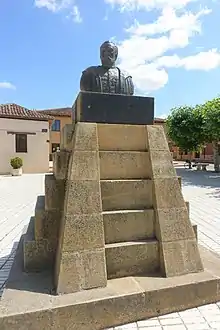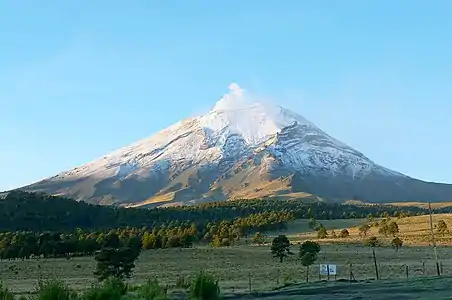Diego de Ordaz
Diego de Ordaz also Diego de Ordás (Spanish: [ˈdjeɣo ðe oɾˈðaθ]; 1480 in Castroverde de Campos, Zamora province, Spain – 1532 in Venezuela) was a Spanish explorer and soldier.

Early career
Diego de Ordaz arrived in Cuba at a young age. Serving under the orders of Diego Velázquez, he participated in the earliest exploratory expeditions to Colombia and Panamá.
Expedition of Cortés to Mexico
De Ordaz accompanied Hernán Cortés on his expedition of conquest to the Mexican mainland.[1]:48,221 He was recognized for his contribution to the victory over the Aztecs obtained at the Battle of Centla near Río Grijalva in Tabasco on March 25, 1519.
Together with two comrades, he was the first European to climb to the top of the volcano Popocatépetl - a feat which made a great impression on the indigenous allies accompanying Cortés. In recognition of De Ordaz's military deeds, the emperor Charles V on October 22, 1525 issued a decree permitting him to use a coat-of-arms featuring a view of the volcano.[1]:182–183
De Ordaz participated in the Spanish conquest of Tenochtitlán, the Aztec capital. When prior to the final conquest, the Spaniards were forced to flee from the capital in a nocturnal action known as La Noche Triste ("the sad night"), De Ordaz was wounded.
Following the conquest of Mexico, De Ordaz explored the areas of Oaxaca and Veracruz, and navigated the Río Coatzacoalos.
In 1521, he was sent back to Spain in order to present the story of the conquest of Mexico to the Spanish court, and in order to obtain for Cortės the title of Governor and General Captain of New Spain.
Search for El Dorado
De Ordaz returned to North America in approximately 1525. In 1529, he was granted the property of El Peñón de los Baños located within the limits of Mexico City.
He returned again to Spain and requested permission to explore Venezuela as it was believed at the time that gold "grew" better near the equator. In Venezuela, he learned from the natives of an El Dorado-like kingdom known as Manõa said to exist beyond a mountain on left bank of the Orinoco River.[2] After failing to find Manõa, he decided to return to Spain but died in 1532 on the Venezuelan Paria Peninsula.
Legacy

In 1952, a planned city called Puerto Ordaz was founded in Venezuela on the banks of the Orinoco River; today it is one of that country's principal cities.
Diego de Ordaz was one of the principal characters in the anonymous historical novel Jicoténcal published in Philadelphia in 1826 and attributed to several different writers like Felix Varela, José María Heredia, and Félix Mejía.
References
- Diaz, B., 1963, The Conquest of New Spain, London: Penguin Books, ISBN 0140441239
- John Hemming, The search for El Dorado pg 15

